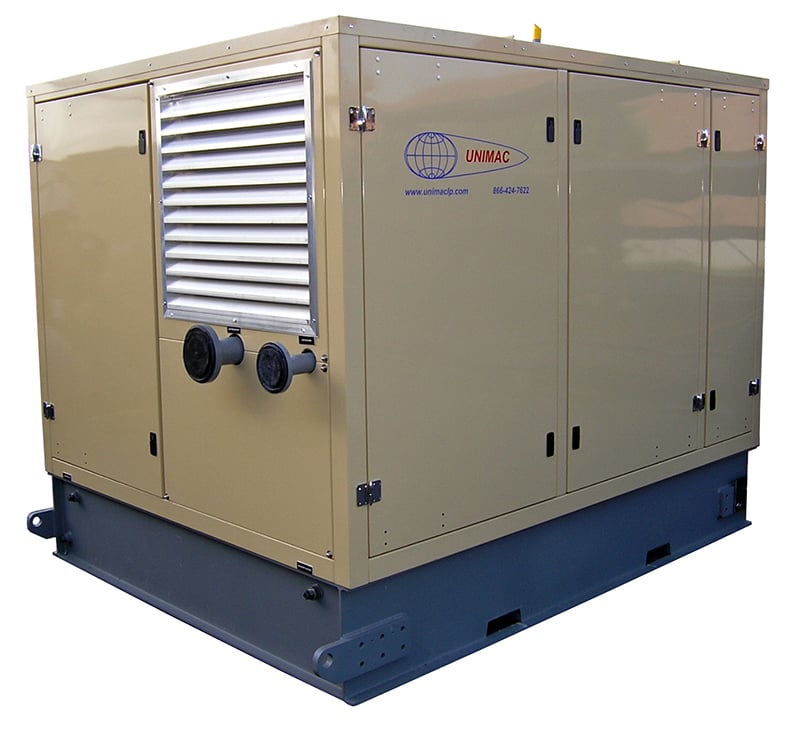VRUs
Unimac’s Vapor Recovery Units are backed by decades of reliable service in applications such as Oil & Gas, and Biogas collection. Our Vapor Recovery Units help capture fugitive vapors and knock out condensate to provide a usable gas stream.

Vapor Recovery Unit Packages
Recovery of hydrocarbons including methane and other volatile organic compounds (VOC), natural gas liquids (NGLs), and hazardous air pollutants (HAP), can yield significant economic savings while at the same time reducing emissions by up to 95%. To learn more about identifying possible installation locations and determining the value of the recovered emissions, see the information below.
VRU packages are designed to handle the wet gas streams inherent in a vapor recovery application. Large suction scrubbers effectively separate condensate from the gas and drain to waste or back to the stock tank.
The bypass system automatically responds to minute pressure changes as small as 0.5 inches W.C. diverting a portion of the discharge stream back to the suction scrubber. Stock tank pressures are maintained at 1 to 3 oz, in addition multiple control devices protect the production facility from positive or negative pressures.
VRU Packages are pre-engineered, featuring either an electric or natural gas engine driver. Basic units include all of the necessary primary components, safety devices and controls to provide a complete solution when combined with properly configured tanks. Standard units are customizable with numerous options available to choose from.
About Vapor Recovery
Storage tanks are used to hold oil for periods of time stabilizing flow between production wells and transportation sites. During storage, light hydrocarbons dissolved in the crude oil “flash out” and collect in the space between the liquid and the fixed roof of the tank. As the liquid level in the tank changes, these vapors are often vented to the atmosphere. The makeup of these vapors varies, but the largest component is methane (between 40 and 60 percent). Other components include more complex hydrocarbon compounds such as propane, butane, and ethane; natural inert gases such as nitrogen and carbon dioxide; and HAP like benzene, toluene, ethyl-benzene, and xylene (collectively these four HAP are referred to as BTEX).
VRUs (Vapor Recovery Units) are relatively simple systems that can capture about 95 percent of the Btu-rich vapors for sale or for use onsite as fuel. Recovered vapors contain natural gas liquids that have a Btu content that is higher than that of pipeline quality natural gas (between 950 and 1,100 Btu per standard cubic foot [scf]).
Depending on the volume of NGLs in the vapors, the Btu content can reach as high as 2,000 Btu per scf. VRUs can provide significant environmental and economic benefits.
Benefits of Vapor Recovery
- Installing a Vapor Recovery Unit can be very profitable when the recovered vapors are sent to sale pipelines. Even using a conservative estimate of the value of recovered vapors of $3.00 per Mcf, the potential returns are attractive, particularly for the larger units.
- Average payback ranges from 3 months to 3 1/2 years
- Recovered vapors can be used onsite as fuel yields a value equivalent to the purchased fuel that is displaced—typically natural gas
- Vapor Recovery Units capture HAPs (hazardous air pollutants) and can reduce emissions below actionable levels. By capturing methane, VRUs also reduce the emissions of greenhouse gases.

Five Steps for assessing VRU economics
- Identify possible locations for VRU installation
- Quantify the volume of vapor emissions
- Determine the value of the recovered emissions
- Determine the cost of a VRU project
- Evaluate VRU project economics
The Natural GasSTAR Partners published a twelve page “Lessons Learned” article titled Installing Vapor Recovery Units on Crude Oil Storage Tanks. This Executive summary can be viewed and downloaded by clicking the following link…
VRU Packages are pre-engineered, featuring either an electric or natural gas engine driver. Basic units include all of the necessary primary components, safety devices and controls to provide a complete solution when combined with properly configured tanks. Standard units are customizable with numerous options available to choose from.


